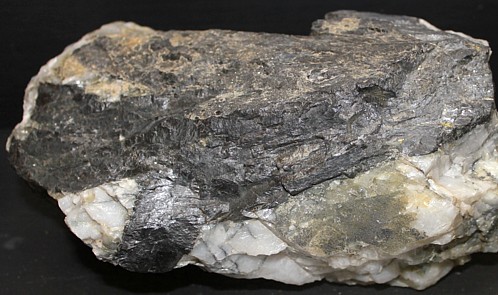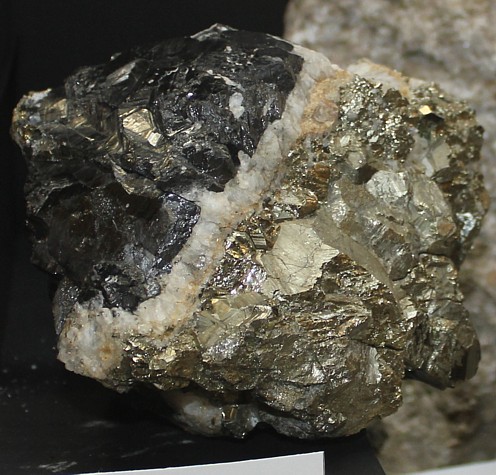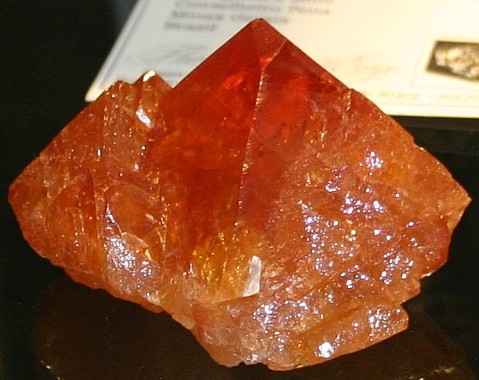Tungsten is a rare acid-forming heavy metal found chiefly in the tungstates of iron and calcium, wolframite and scheelite. Tungsten is not found native, but is produced in the form of a greyish-black powder, which when fused has a specific gravity of 19.25, virtually the same as gold at 19.3. I recent years some cases of gold plated tungsten bars masquerading as gold have surfaced. The name tungsten was first used by Cronstedt, and signifies "heavy stone." The chief ore is wolfram, which is usually associated with cassiterite, and for a long time the effective separation of these minerals was a matter of some difficulty. Tungsten minerals were once recovered from tungsten ores by mechanical concentration using their density. A better process was developed, using both by electromagnetic separation, followed by roasting the crushed ore with sodium carbonate, by which operation sodium tungstate is formed, and the tin ores can be removed. In the case of several tin mining companies the presence of wolfram enables profits to be made, which but for the "mixed minerals" would be impossible.
Tungsten is mainly used in the production of hard materials based on tungsten carbide, one of the hardest carbides, with a melting point of 2770 °C. Tungsten carbide is an efficient electrical conductor, but W2C is less so. Tungsten carbide is used to make wear-resistant abrasives and cutters and knives for drills, circular saws, milling and turning tools used by the metalworking, woodworking, mining, petroleum and construction industries and accounts for about 60% of current tungsten consumption, and there does not appear to be any slackening in the demand. A secondary use to which tungsten is put is as a steel hardening agent. The hardness and density of tungsten are applied in obtaining heavy metal alloys. A good example is high speed steel, which can contain as much as 18% tungsten. Tungsten steels hold their temper at high temperatures and are therefore valuable for the making of high speed tools, etc. Tungsten is planned for steel alloys is usually produced in the form of ferro-tungsten alloys produced in the electric furnace. The alloys are also used for tool steels. Other uses are for the manufacture of electric light bulb filaments. Tungsten salts are used as mordants and for fire-proofing purposes. Two oxides of tungsten are known WO2 and WO3. WO3 is known by the name of tungstic acid, and from it are formed various salts called tungstates, several of which occur as minerals. Tungstic acid, WO3, occurs as the mineral tungstic ochre, found as an alteration product of the mineral tungstates.
The most common tungsten minerals are Wolfram, Hubnerite, Ferberite and Scheelite. They are all associated with the acid intrusive rocks, such as granites and pegmatites, rather than the ultra-basic rocks, like peridotite. Wolframite and hebnerite are by far the more important ore minerals of tungsten, scheelite being much less important. However, in the western US, sheelite has been the most common tungsten ore mineral. Wolframite and hebnerite constitute an isomorphous series. At one end of the series there is iron tungstate (FeW04) to which the name ferberite has been given; at the other end is hebnerite (MnW04). These two occur mixed in all proportions. Some writers use the names ferberite and hebnerite for the extreme types and wolframite for the intermediate types. Others recognize only two species in this series, one in which the iron tungstate predominates over the manganese tungstate (wolframite including ferberite) while in the other species (hebnerite) manganese tungstate is predominant. As in other isomorphous series of this kind, there is a gradation in physical properties, and in this particular case the color deepens and the mineral becomes more opaque as the percentage of iron increases. Tungsten minerals occur as lens shaped masses in the early segregation of an acid magma; in veins cutting acid intrusive rocks; in limestone, by metasomatic replacement; and as skarn deposits formed in contact metamorphic environments between limestone and acidic intrusive rocks.
Tungsten ore concentrates (chiefly wolframite) appear on the market in the form of concentrates, varying between 60 percent and 70 percent tungstic acid (WO3), and are purchased on the basis of their tungstic acid content. Seventy percent material is exceptionally good quality, and grades lower than 60 per cent, are saleable, but are subject to penalization. China is by far the world leader in tungsten production, having produced 56,000 tons of tungsten concentrate in 2009, which was 83% of the world output. Most of the remaining production originated from Russia (2,500 t), Canada (1,964 t), Bolivia (1,023 t), Austria (900 t), Portugal (900 t), Thailand (600 t), Brazil (500 t), Peru (500 t) and Rwanda (500 t).
WOLFRAMITE VEINS
Wolframite, including the tungstate of iron (ferberite) and the
tungstate of manganese (hebnerite), has a field of occurrence similar to
that of cassiterite. It appears in igneous rocks, in pegmatites, in
cassiterite veins, and sometimes with
quartz and bismuth minerals in veins which are evidently of
the deep-seated type and allied to the tin veins. But, unlike cassiterite,
wolframite also appears abundantly in veins formed under much more moderate
temperature and pressure for instance, in those of Boulder County, Colorado.
Small quantities of hebnerite are found in veins formed near the surface, as
in those of Tonopah, Nevada, and Cripple Creek, Colorado. The principal
production in the United States is derived from Boulder County, Colorado
where the principal tungsten ore is ferberite, which occurs in small veins
in granite. Hebnerite and wolframite have formed placers that are worked in
the Little Dragoon Mountains, Arizona.
Wolframite veins of the deep-seated type have been described from the Deer Park district, in Washington and from sources in the Sierra de Cordova in Argentina. Wolframite lodes of great importance have lately been developed in the Tavoy district, These minerals are found in lower Myanmar, where they occur in granite and metamorphic schist and contain in addition quartz, mica, tourmaline, columbite, arsenopyrite, pyrite, bismuthinite and galena. At the same place wolframite is also recovered from alluvial deposits. In 1916 the mines of lower Myanmar produced about 3,000 tons of wolframite concentrates, which was about one-third of the annual output of the world. The crude ore is said to average 1.3 per cent. WO3 per ton.
SCHEELITE DEPOSITS
Scheelite (CaWO4), a heavy white mineral of non-metallic luster, occurs
in many contact-metamorphic deposits. The scheelite is associated with
garnet,
calcite, hornblende and pyroxene. Other metallic minerals are
rare. In the early 1900s, this type scheelite deposit was discovered in
Mono, Inyo County, California. In the same time frame, several such deposits
were discovered and worked in the Humboldt Range, Nevada, particularly near
Mill City. The association here is calcite, scheelite, garnet,
epidote and pyrite, and the deposit occurs in limestone close
to granite and is intersected by a dike of aplite. A number of sheelite
based scarn deposits have been worked extensively in California, Nevada and
Utah where they have been of considerable economic importance.
In spite of the number of deposits that have been found, it is possible that many such deposits have been overlooked. At Atolia in San Bernardino, California, schists cut by granite, scheelite is found in gold-bearing quartz veins. Locally, around Atolia the sands and residual surface materials have been worked as placers.
Tests. Tungsten salts color the microcosmic bead blue in the reducing flame. Tungsten minerals, fused with sodium carbonate and dissolved in hydrochloric acid, give, on the addition of a small piece of tin or zinc, a blue solution when heated.
Return
to Metal Ores Page:
Precious and Base Metal Ores

Above: Black wolframite, the most important tungsten ore on a worldwide basis.

Above: Wolframite (black) with white quartz and pyrite

Above: Scheelite, the most important tungsten ore in the USA.
